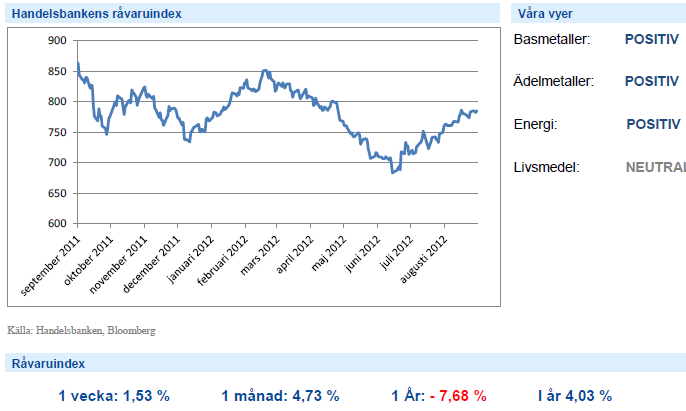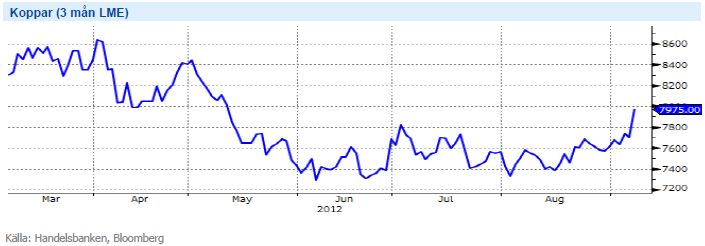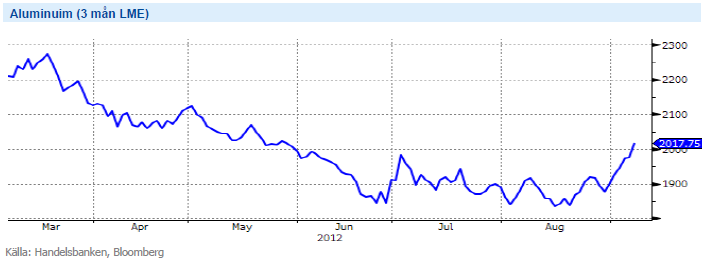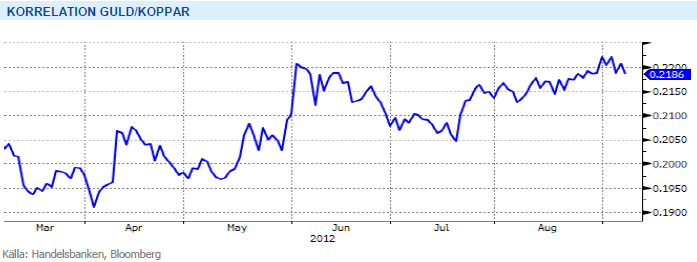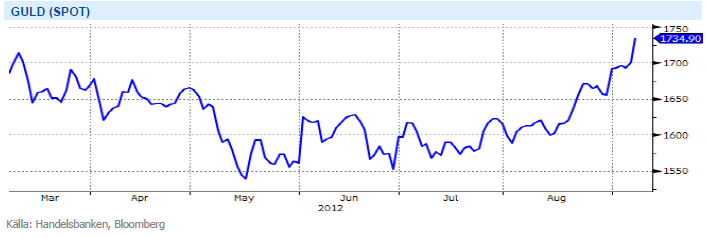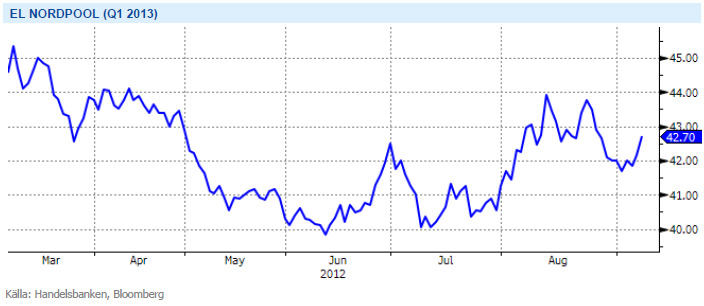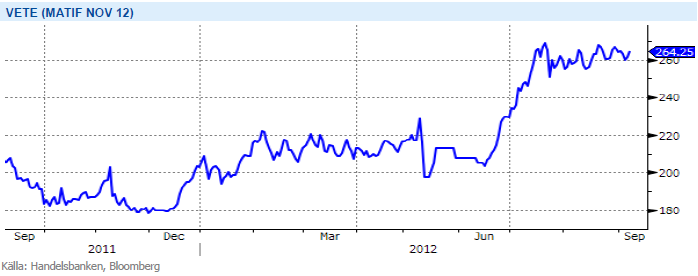Analys
SHB Råvarubrevet 7 september 2012
 Råvaror Allmänt
Råvaror Allmänt
ECB ger stöd åt råvaror
Råvaror har, precis som övriga marknaden fått bra stöd under veckan av ECB-mötet. Detta trots att utfallet av ECB-mötet blev i linje med tidigare läckta uppgifter. Det tog lite tid men sedan blev det kraftiga marknadsrörelser uppåt. Efter att amerikanska centralbankens chef Bernankes dito prestation förra veckan är de två stora riskerna på nedsidan ”bortpratade”.
Makroekonomin hamnar i skymundan när centralbankerna gör så här stora marknadspåverkande ingrepp och vi förväntar oss att det kommer ge stöd åt riskhandlade tillgångar som råvaror under en tid framöver. Nästa vecka kommer mer från Fed, torsdagen den 13e släpper man räntebesked och kl 20:15 har Bernanke presskonferens. Guldet har åter fått styrfart efter att centralbankerna börjat agera på problemen i realekonomin och vi räknar med att det fortsätter.
Basmetaller
Basmetallerna på uppgång
Aluminium och koppar har haft rejäla uppgångar under veckan; aluminium är upp drygt 5 % och koppar är upp drygt 3 %. Risksentimentet har givetvis lyft priserna men även rapporter om ökad efterfrågan från industrin har hjälpt till.
När det gäller aluminium står USA för 9 % av konsumtionen och framförallt bilproducenterna och maskintillverkare har visat på större inköp. Det som har stött kopparpriset är att Kina annonserat flera kopparintensiva infrastrukturprojekt. Vi är fortsatt positiva till basmetaller på dessa nivåer, framförallt beroende på en starkare världskonjunktur och Kinas återhämtning.
Kinas makrodata har ännu inte bjudit på positiva överraskningar men Kinas dåliga konjunktur är nu inprisad i råvarorna och de faller inte när kinadata kommer ut. Vi tycker att basmetallerna, som har 50 % exponering mot Kina, handlas på attraktiva nivåer och de bjuder på en intressant uppsida när Kinas konjunkturåterhämtning kommer. Vi ser även att den positiva riskaptiten, drivet av centralbankernas stimulanser ger stöd åt prisbilden.
Lång BULL BASMET H
Ädelmetaller
Centralbankernas stimulanser driver guldet
Dagens amerikanska arbetslöshetssiffror satte bra fart på guldpriset och det har i eftermiddag stigit över två procent. Som vi skriver i inledningen av veckans brev tror vi att centralbanksstimulanser kommer att driva priset ytterligare på ädelmetaller, och dagens arbetslöshetssiffror förstärker tron på dessa stimulansåtgärder.
Ädelmetaller har fortsatt hög korrelation med basmetaller, och sedan sommaren har guld och koppar rört sig helt hand i hand (se bild), och vi ser ingen anledning till att denna korrelation ska släppa i närtid.
Vårt ädelmetallsindex har stigit med 10 % under den senaste månaden där inte minst silver har visat på styrka med närmare 17 % i värdestegring. I platinumgruvan i sydafrika fortsätter oroligheterna vilket har fått platinumpriset att rusa, nästan 14 % upp på en månad.
Vi på Handelsbanken tror att centralbankernas fortsatta stimulansåtgärder kommer fortsätta att ge stöd åt ädelmetaller, lett av guld.
Lång ADELMET H
Energi
Produktionsstörningar ger stöd åt oljan
Oljemarknaden backar 1.5 procent under veckan efter sämre amerikanska arbetslöshets siffror och rykten kring att delar av landets strategiska lager kan komma ut på marknaden. Faktorer som fallande lagersiffror under augusti (-7.4 miljoner fat mot -5.3 förväntat från US DOE), ökad spänning mellan Israel och Iran samt uppreviderade förbrukningssiffror (+2.7 procent y-o-y) och OPECs låga reservkapacitet (idag 1.4 miljoner fat / dag eller 1.5 procent att jämföra med 3 procent under 1H2012 och 1 procent 2008 när Brent nådde 147 dollar) visar på att marknaden är fortsatt väldigt känslig för produktionsstörningar. Detta är anledningen till varför man nu talar så mycket om de strategiska lagren USA kan komma att använda för att få situationen under kontroll. Vi ser dock den låga reservkapaciteten som ett fortsatt problem för marknaden.
Elpriset pressas fortsatt av stora nederbördsmängder, hög vindkraftsproduktion samt återstart av både Forsmark 1 och Oskarshamn 3. Även kommande 10 dagars period ser ut att ge mer regn än normalt, uppemot 9.7 TWh mot normala 6.1 TWh, vilket skulle innebära att energibalansen stärks med ytterligare 2.5 TWh till +9.5 TWh mot slutet av vecka 37. När inte heller kolet förväntas stiga nämnvärt är det svårt att se någon direkt potential för uppgång på den korta elkurvan. SHB Power Index följer numer kontraktet Q1 2013 som stängde på 42.70 (5.5 euro över Q4 2012). Att däremot köpa den längre kurvan på nivåer om 34.5 öre / kWh måste däremot ses som väldigt attraktiva nivåer.
Olja är den mest finansiellt handlade råvaran, i en redan stram marknad med störningar på utbudssidan tror vi att ökad riskvilja hos investerare efter ECBs och Feds aktioner kan driva olja ytterligare. Vi bedömer dock att det finns en finansiellt driven riskpremie i oljan på grund av oron kring Israels krigsvilja, denna kan snabbt pysa ut om situationen lugnar ner sig.
Lång OLJA H
Livsmedel
Fortsatt torrt i Australien
I USA är skörden av vårvete nästan helt klar och kvalitetsnivåer uppges överlag vara tillfredställande. Nu kommer allt mer fokus läggas på sådden av höstvete, för vilket det idag inte finns någon jättestor oro även om mer nederbörd är önskvärt. I Australien är dock fortfarande oron ganska stor, i stort sett inget regn väntas under de närmaste två veckorna samtidigt som grödan går in i en allt mer kritisk period. Ett torrt år i Australien sänker ofta avkastningsnivån 30-40 procent så marknaden lär följa detta noggrant.
Skörden fortsätter i Ryssland med torrt väder så ingen fördröjning att nämna för det vete som står kvar ute på fält, kvalitetsnivån uppges dock vara ganska varierande. Längst ner i söder har sådden startat (ca. 15% klart) under vad jag hört utmärkta förhållanden. I veckan har de spannmålsexporterande företagen i Ukraina kommit överens med regeringen om att frivilligt begränsa exporten av vete innevarande säsong till 4 miljoner ton, vilket innebär att USDA i nästa veckas rapport får justera ned sina förväntningar med 2 miljoner ton. För tillfället kan det vara svårt att se varför priserna på vete ska gå ned på kort sikt, inte minst på grund av problemen i Australien. Ser vi lite längre fram och funderar över prisnivån vid skörd nästa år är det däremot svårare att se varför dagens historiskt sett höga nivå ska hålla i sig. Dagens höga priser bör leda till att de som kan ökar sin odlade areal och även om (som vanligt) väldigt mycket kan hända innan skörd har i alla fall sådden fått en väldigt bra start överallt.
Torka i Västafrika och spekulation om El Ninos negativa inverkan på den kommande kakaoskörden där och i Indonesien, har fått kakao priset att stiga i veck-an. Kakao handlar nu på 10mån högsta. ICO (International Coffee Organization) presenterade sin rapport för augusti tidigare i veckan. Estimatet för den totala kaffeproduktionen 2011/12 är ca 132,7 miljoner säckar, vilket är något färre än året innan (-1,2 %).
För apelsinjuicens del är det stor fokus på den pågående orkansäsongen. Priset på apelsinjuice har stärkts under den gångna veckan och ”Leslie” är den senaste av orkaner som kan komma att drabba apelsinodlingarna i Florida de kommande dagarna.
Handelsbankens Råvaruindex
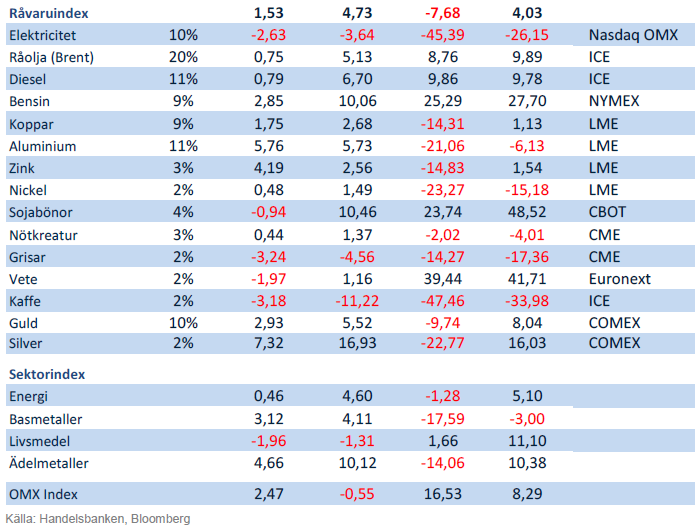
Handelsbankens råvaruindex består av de underliggande indexen för respektive råvara. Vikterna är bestämda till hälften från värdet av global produktion och till hälften från likviditeten i terminskontrakten.
[box]SHB Råvarubrevet är producerat av Handelsbanken och publiceras i samarbete och med tillstånd på Råvarumarknaden.se[/box]
Ansvarsbegränsning
Detta material är producerat av Svenska Handelsbanken AB (publ) i fortsättningen kallad Handelsbanken. De som arbetar med innehållet är inte analytiker och materialet är inte oberoende investeringsanalys. Innehållet är uteslutande avsett för kunder i Sverige. Syftet är att ge en allmän information till Handelsbankens kunder och utgör inte ett personligt investeringsråd eller en personlig rekommendation. Informationen ska inte ensamt utgöra underlag för investeringsbeslut. Kunder bör inhämta råd från sina rådgivare och basera sina investeringsbeslut utifrån egen erfarenhet.
Informationen i materialet kan ändras och också avvika från de åsikter som uttrycks i oberoende investeringsanalyser från Handelsbanken. Informationen grundar sig på allmänt tillgänglig information och är hämtad från källor som bedöms som tillförlitliga, men riktigheten kan inte garanteras och informationen kan vara ofullständig eller nedkortad. Ingen del av förslaget får reproduceras eller distribueras till någon annan person utan att Handelsbanken dessförinnan lämnat sitt skriftliga medgivande. Handelsbanken ansvarar inte för att materialet används på ett sätt som strider mot förbudet mot vidarebefordran eller offentliggörs i strid med bankens regler.
Analys
More weakness and lower price levels ahead, but the world won’t drown in oil in 2026

Some rebound but not much. Brent crude rebounded 1.5% yesterday to $65.47/b. This morning it is inching 0.2% up to $65.6/b. The lowest close last week was on Thursday at $64.11/b.

The curve structure is almost as week as it was before the weekend. The rebound we now have gotten post the message from OPEC+ over the weekend is to a large degree a rebound along the curve rather than much strengthening at the front-end of the curve. That part of the curve structure is almost as weak as it was last Thursday.
We are still on a weakening path. The message from OPEC+ over the weekend was we are still on a weakening path with rising supply from the group. It is just not as rapidly weakening as was feared ahead of the weekend when a quota hike of 500 kb/d/mth for November was discussed.
The Brent curve is on its way to full contango with Brent dipping into the $50ies/b. Thus the ongoing weakening we have had in the crude curve since the start of the year, and especially since early June, will continue until the Brent crude oil forward curve is in full contango along with visibly rising US and OECD oil inventories. The front-month Brent contract will then flip down towards the $60/b-line and below into the $50ies/b.
At what point will OPEC+ turn to cuts? The big question then becomes: When will OPEC+ turn around to make some cuts? At what (price) point will they choose to stabilize the market? Because for sure they will. Higher oil inventories, some more shedding of drilling rigs in US shale and Brent into the 50ies somewhere is probably where the group will step in.
There is nothing we have seen from the group so far which indicates that they will close their eyes, let the world drown in oil and the oil price crash to $40/b or below.
The message from OPEC+ is also about balance and stability. The world won’t drown in oil in 2026. The message from the group as far as we manage to interpret it is twofold: 1) Taking back market share which requires a lower price for non-OPEC+ to back off a bit, and 2) Oil market stability and balance. It is not just about 1. Thus fretting about how we are all going to drown in oil in 2026 is totally off the mark by just focusing on point 1.
When to buy cal 2026? Before Christmas when Brent hits $55/b and before OPEC+ holds its last meeting of the year which is likely to be in early December.
Brent crude oil prices have rebounded a bit along the forward curve. Not much strengthening in the structure of the curve. The front-end backwardation is not much stronger today than on its weakest level so far this year which was on Thursday last week.

The front-end backwardation fell to its weakest level so far this year on Thursday last week. A slight pickup yesterday and today, but still very close to the weakest year to date. More oil from OPEC+ in the coming months and softer demand and rising inventories. We are heading for yet softer levels.

Analys
A sharp weakening at the core of the oil market: The Dubai curve

Down to the lowest since early May. Brent crude has fallen sharply the latest four days. It closed at USD 64.11/b yesterday which is the lowest since early May. It is staging a 1.3% rebound this morning along with gains in both equities and industrial metals with an added touch of support from a softer USD on top.

What stands out the most to us this week is the collapse in the Dubai one to three months time-spread.
Dubai is medium sour crude. OPEC+ is in general medium sour crude production. Asian refineries are predominantly designed to process medium sour crude. So Dubai is the real measure of the balance between OPEC+ holding back or not versus Asian oil demand for consumption and stock building.
A sharp weakening of the front-end of the Dubai curve. The front-end of the Dubai crude curve has been holding out very solidly throughout this summer while the front-end of the Brent and WTI curves have been steadily softening. But the strength in the Dubai curve in our view was carrying the crude oil market in general. A source of strength in the crude oil market. The core of the strength.
The now finally sharp decline of the front-end of the Dubai crude curve is thus a strong shift. Weakness in the Dubai crude marker is weakness in the core of the oil market. The core which has helped to hold the oil market elevated.
Facts supports the weakening. Add in facts of Iraq lifting production from Kurdistan through Turkey. Saudi Arabia lifting production to 10 mb/d in September (normal production level) and lifting exports as well as domestic demand for oil for power for air con is fading along with summer heat. Add also in counter seasonal rise in US crude and product stocks last week. US oil stocks usually decline by 1.3 mb/week this time of year. Last week they instead rose 6.4 mb/week (+7.2 mb if including SPR). Total US commercial oil stocks are now only 2.1 mb below the 2015-19 seasonal average. US oil stocks normally decline from now to Christmas. If they instead continue to rise, then it will be strongly counter seasonal rise and will create a very strong bearish pressure on oil prices.
Will OPEC+ lift its voluntary quotas by zero, 137 kb/d, 500 kb/d or 1.5 mb/d? On Sunday of course OPEC+ will decide on how much to unwind of the remaining 1.5 mb/d of voluntary quotas for November. Will it be 137 kb/d yet again as for October? Will it be 500 kb/d as was talked about earlier this week? Or will it be a full unwind in one go of 1.5 mb/d? We think most likely now it will be at least 500 kb/d and possibly a full unwind. We discussed this in a not earlier this week: ”500 kb/d of voluntary quotas in October. But a full unwind of 1.5 mb/d”
The strength in the front-end of the Dubai curve held out through summer while Brent and WTI curve structures weakened steadily. That core strength helped to keep flat crude oil prices elevated close to the 70-line. Now also the Dubai curve has given in.
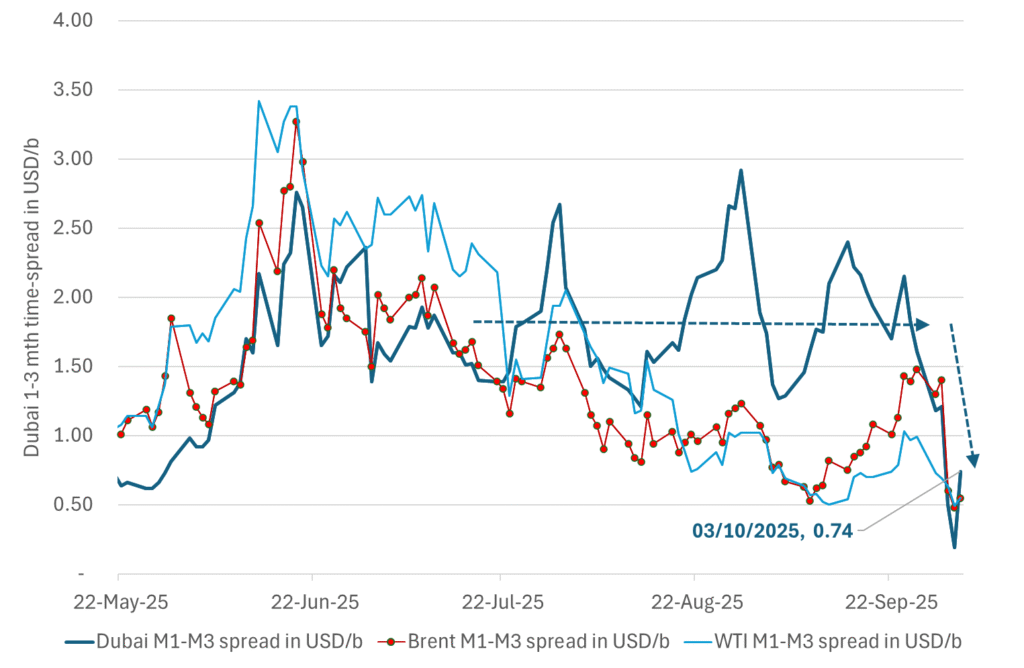
Brent crude oil forward curves

Total US commercial stocks now close to normal. Counter seasonal rise last week. Rest of year?
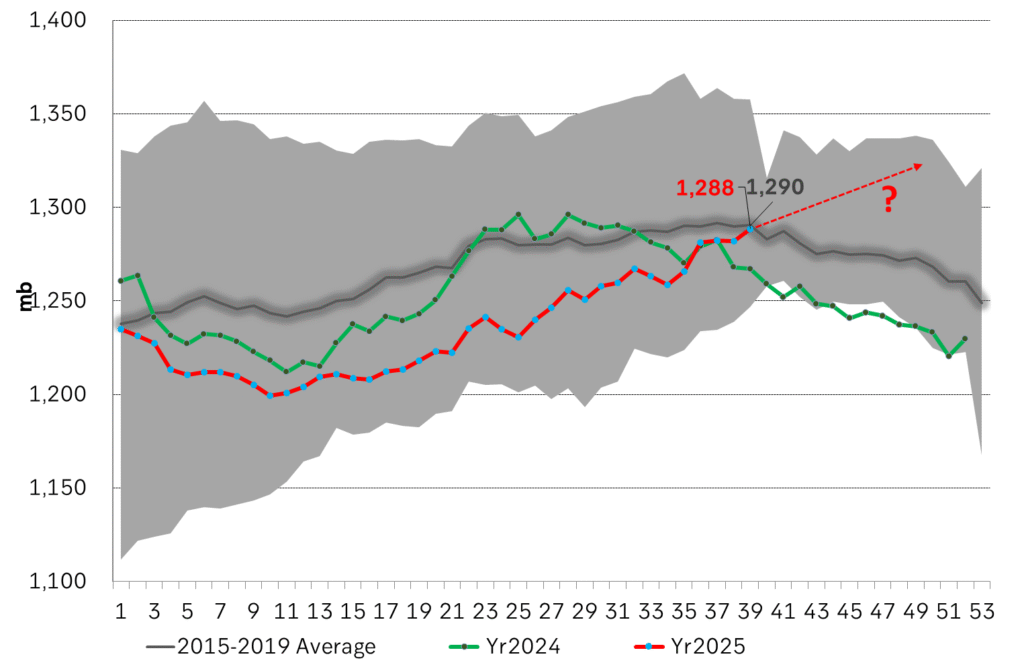
Total US crude and product stocks on a steady trend higher.
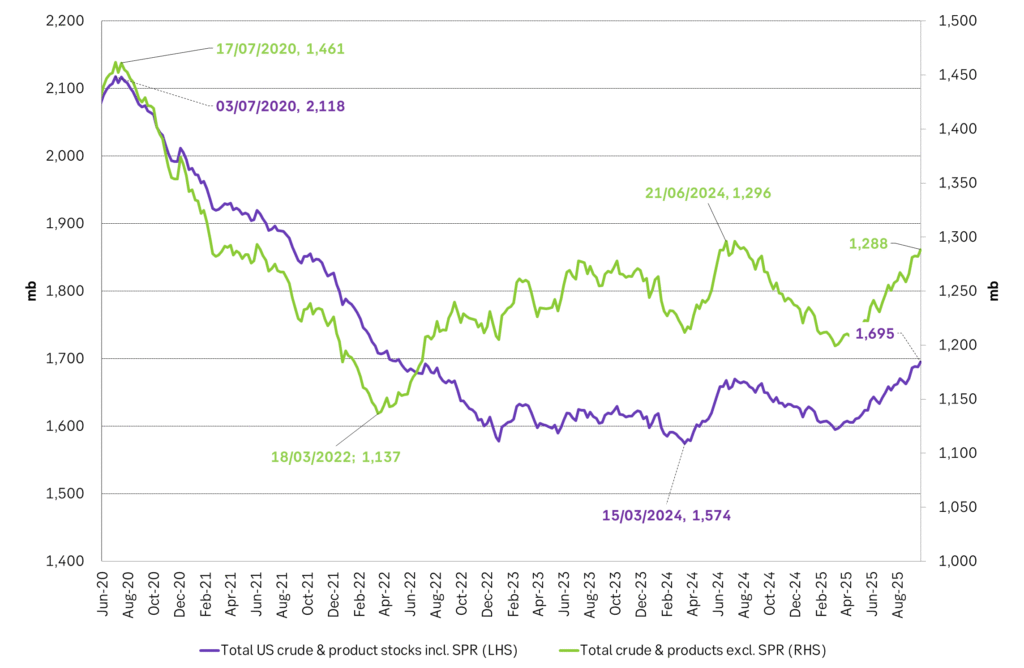
Analys
OPEC+ will likely unwind 500 kb/d of voluntary quotas in October. But a full unwind of 1.5 mb/d in one go could be in the cards

Down to mid-60ies as Iraq lifts production while Saudi may be tired of voluntary cut frugality. The Brent December contract dropped 1.6% yesterday to USD 66.03/b. This morning it is down another 0.3% to USD 65.8/b. The drop in the price came on the back of the combined news that Iraq has resumed 190 kb/d of production in Kurdistan with exports through Turkey while OPEC+ delegates send signals that the group will unwind the remaining 1.65 mb/d (less the 137 kb/d in October) of voluntary cuts at a pace of 500 kb/d per month pace.

Signals of accelerated unwind and Iraqi increase may be connected. Russia, Kazakhstan and Iraq were main offenders versus the voluntary quotas they had agreed to follow. Russia had a production ’debt’ (cumulative overproduction versus quota) of close to 90 mb in March this year while Kazakhstan had a ’debt’ of about 60 mb and the same for Iraq. This apparently made Saudi Arabia angry this spring. Why should Saudi Arabia hold back if the other voluntary cutters were just freeriding? Thus the sudden rapid unwinding of voluntary cuts. That is at least one angle of explanations for the accelerated unwinding.
If the offenders with production debts then refrained from lifting production as the voluntary cuts were rapidly unwinded, then they could ’pay back’ their ’debts’ as they would under-produce versus the new and steadily higher quotas.
Forget about Kazakhstan. Its production was just too far above the quotas with no hope that the country would hold back production due to cross-ownership of oil assets by international oil companies. But Russia and Iraq should be able to do it.
Iraqi cumulative overproduction versus quotas could reach 85-90 mb in October. Iraq has however steadily continued to overproduce by 3-5 mb per month. In July its new and gradually higher quota came close to equal with a cumulative overproduction of only 0.6 mb that month. In August again however its production had an overshoot of 100 kb/d or 3.1 mb for the month. Its cumulative production debt had then risen to close to 80 mb. We don’t know for September yet. But looking at October we now know that its production will likely average close to 4.5 mb/d due to the revival of 190 kb/d of production in Kurdistan. Its quota however will only be 4.24 mb/d. Its overproduction in October will thus likely be around 250 kb/d above its quota with its production debt rising another 7-8 mb to a total of close to 90 mb.
Again, why should Saudi Arabia be frugal while Iraq is freeriding. Better to get rid of the voluntary quotas as quickly as possible and then start all over with clean sheets.
Unwinding the remaining 1.513 mb/d in one go in October? If OPEC+ unwinds the remaining 1.513 mb/d of voluntary cuts in one big go in October, then Iraq’s quota will be around 4.4 mb/d for October versus its likely production of close to 4.5 mb/d for the coming month..
OPEC+ should thus unwind the remaining 1.513 mb/d (1.65 – 0.137 mb/d) in one go for October in order for the quota of Iraq to be able to keep track with Iraq’s actual production increase.
October 5 will show how it plays out. But a quota unwind of at least 500 kb/d for Oct seems likely. An overall increase of at least 500 kb/d in the voluntary quota for October looks likely. But it could be the whole 1.513 mb/d in one go. If the increase in the quota is ’only’ 500 kb/d then Iraqi cumulative production will still rise by 5.7 mb to a total of 85 mb in October.
Iraqi production debt versus quotas will likely rise by 5.7 mb in October if OPEC+ only lifts the overall quota by 500 kb/d in October. Here assuming historical production debt did not rise in September. That Iraq lifts its production by 190 kb/d in October to 4.47 mb/d (August level + 190 kb/d) and that OPEC+ unwinds 500 kb/d of the remining quotas in October when they decide on this on 5 October.
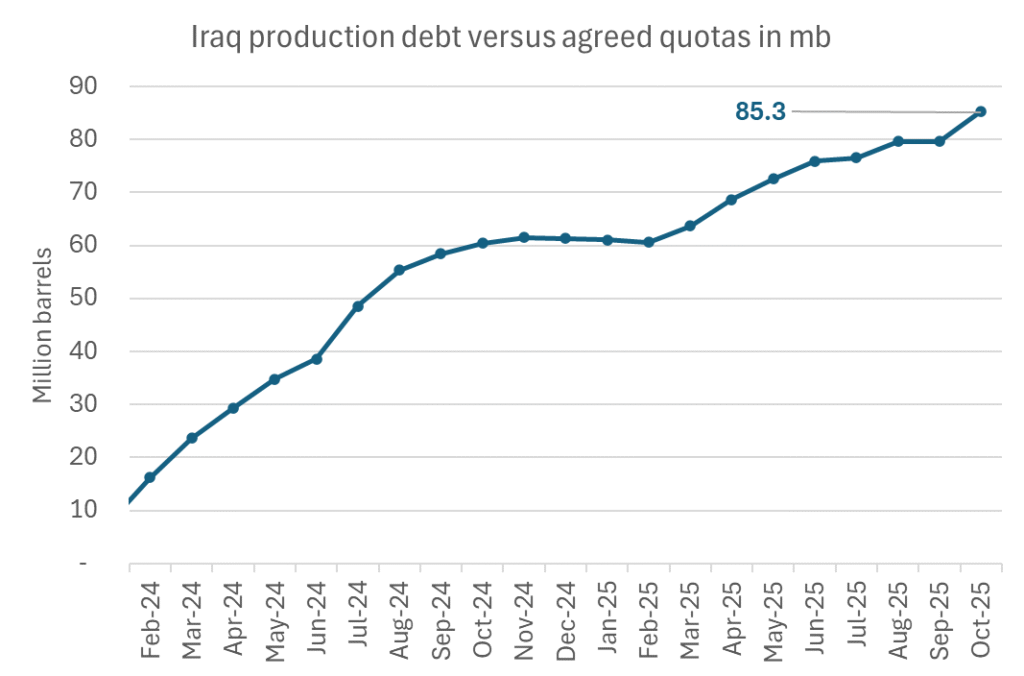
-

 Nyheter4 veckor sedan
Nyheter4 veckor sedanMahvie Minerals i en guldtrend
-

 Analys4 veckor sedan
Analys4 veckor sedanVolatile but going nowhere. Brent crude circles USD 66 as market weighs surplus vs risk
-
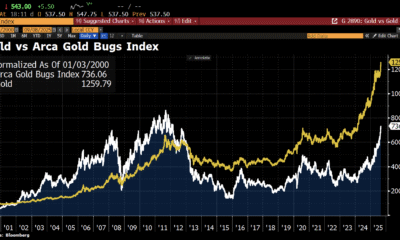
 Nyheter4 veckor sedan
Nyheter4 veckor sedanAktier i guldbolag laggar priset på guld
-

 Nyheter3 veckor sedan
Nyheter3 veckor sedanKinas elproduktion slog nytt rekord i augusti, vilket även kolkraft gjorde
-

 Nyheter3 veckor sedan
Nyheter3 veckor sedanTyskland har så höga elpriser att företag inte har råd att använda elektricitet
-
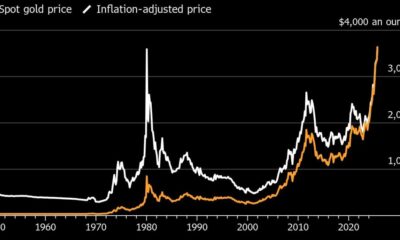
 Nyheter4 veckor sedan
Nyheter4 veckor sedanGuld når sin högsta nivå någonsin, nu även justerat för inflation
-
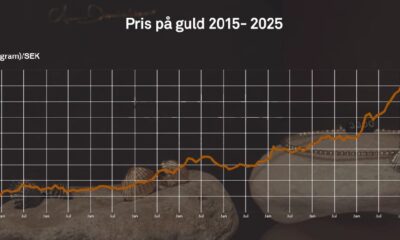
 Nyheter3 veckor sedan
Nyheter3 veckor sedanDet stigande guldpriset en utmaning för smyckesköpare
-

 Analys4 veckor sedan
Analys4 veckor sedanWaiting for the surplus while we worry about Israel and Qatar


